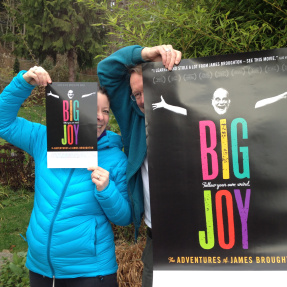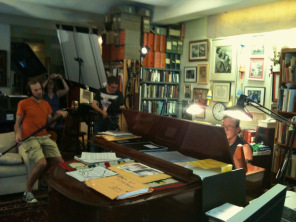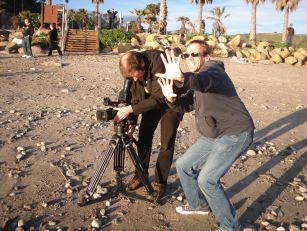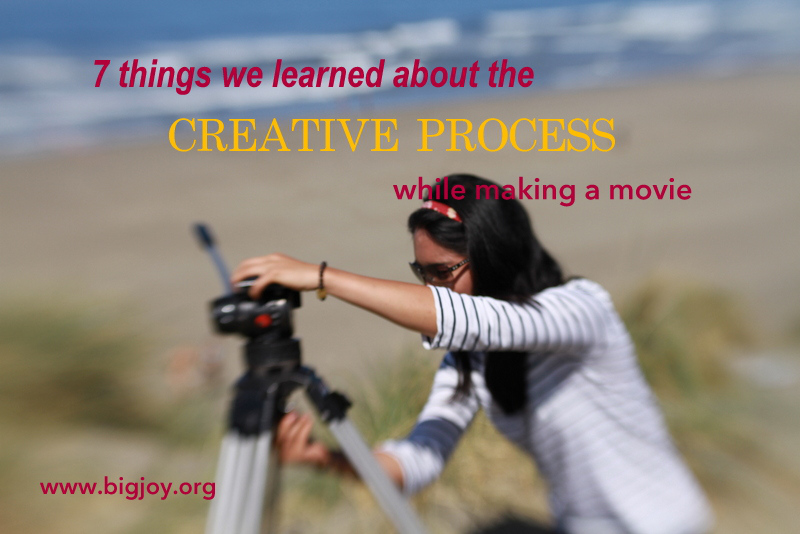By Executive Producer and Co-Director Stephen Silha and Associate Producer Aimée Cartier
This month #BigJoySpark has been looking at creativity. We decided to think about our own creative process in making BIG JOY: The Adventures of James Broughton to see what we’ve learned, so far. Here’s a compilation of our notes on the creative experience of making a film.
1. Serendipity plays a part. If it wasn’t for James Broughton and Stephen Silha being assigned to the same cabin at a men’s gathering at Breitenbush Hot Springs in 1989, this film may have never been made. We noticed that the right people came along at exactly the right time to make the project more  creative and solid than it would have been otherwise. Associate producer Aimée Cartier, for example, was recommended by a mutual friend when the film project was just forming. Holding the seams of a movie together is not usually what she does. And yet, she’s been at it since the beginning, and has been inspired enough by the project to continue to hold a lot of the behind-the-scenes work even today. She uses her natural gifts of intuition and her practicality to keep us moving forward in ways both grounded and inspirational. But we wouldn’t have found her in the classified ads under “Associate Producer!”
creative and solid than it would have been otherwise. Associate producer Aimée Cartier, for example, was recommended by a mutual friend when the film project was just forming. Holding the seams of a movie together is not usually what she does. And yet, she’s been at it since the beginning, and has been inspired enough by the project to continue to hold a lot of the behind-the-scenes work even today. She uses her natural gifts of intuition and her practicality to keep us moving forward in ways both grounded and inspirational. But we wouldn’t have found her in the classified ads under “Associate Producer!”
2. The creative process ebbs and flows. There are highs and lows. You have moments of complete overwhelm sitting in your studio thinking, “How is this ever all going to work, or get done, or get paid for?” And then there are the moments where the synergy is on high. These moments have a vibrancy and magic to them. They move you forward in such tangible ways and let you know that you are on the right track. Oddly enough, these moments, even if

captured on film, aren’t always the ones that make the final cut. One such moment for us was when David del Tredici burst into tears while reading Broughton’s poem Wondrous the Merge, which he had set to music. The words of the poem expressed and brought him again to a feeling he had had when he came out– of being able to love another man freely. And that day the re-reading of it brought him to tears. Everyone present was moved. But we couldn’t use it. Not because it didn’t fit the flavor or the wonder of our film, but when the story was told, it was an element that just didn’t fit with James’s story. (Though it does appear in our DVD extras.)

OLYMPUS DIGITAL CAMERA
3. A work of art has its own existence. As its maker, it’s up to
you to find its path. As James said, “I have never begun a film, however well prepared, that did not prove to have a life of its own and lead me to a region where I did not expect to go.” He also said, “Simplify, clarify, vivify”– which became our motto too while making BIG JOY. In practical terms, it means that some of your favorite moments don’t make it into the film. In our case, it ended up making for some very creative end credits. We just had to put some of those goofy moments in somehow!

4. Making a film is always a fine line between the technical and creative. We had to abandon some interviews because they were out of focus or because the sound wasn’t right. Some of those had really moving scenes or ones that fit the flavor of our film precisely. Bye-bye, sweet moments! But we know you weren’t lost.

5. Ritual boosts creativity. We would often begin our filmmaking with lighting a candle, and inviting the spirit of James to add to the event. Even when it was only a simple reading of a poem that started our session, it seemed to have the effect of letting everyone in the room get on one creative page, or make room for that in their movements.

OLYMPUS DIGITAL CAMERA
6. “Follow your own weird” was also always a guiding force for us. But it doesn’t just mean goofy. The etymology of the word means “fate or destiny” — and to us that meant, “Bring the best of what you are to our project.” Bring your best creative spark. It can be messy trying to harmonize these different sparks, but ultimately it makes for a better, richer, more meaningful product.
7. Like a lot of art, creating film has an unseen mystery of its own. The people involved are touched and changed in varied and mysterious ways. In the end the making of a film goes beyond what anyone sees on the screen. That has its own existence, as do the moments the creators experienced while making it. Most of these will never be known by others—but are meaningful to those involved. Our soundtrack composers Jami Sieber and Evan Schiller regaled us with tales of being doubled over with laughter many times while scoring BIG JOY. The energy behind the film, their unique combination and creative collaboration generated something unique and lovely just for them. Animator Michael Mann reported going through his own inner roller-coaster journey in animating Broughton’s poems and journals. In an endeavor as giant as making a film, these experiences are countless. Creation moves each of us in our own way. And it goes on indefinitely. We are likely to hear only from a tiny fraction of those of you who see our film but still, we are pleased to know the mystery and magic continues beyond what any of us will ever know.


Comments 1
Pingback: Movie+Discussion = Spice & Flavor Here’s Our Discussion Guide Especially for Experimental Film Lovers | Big Joy